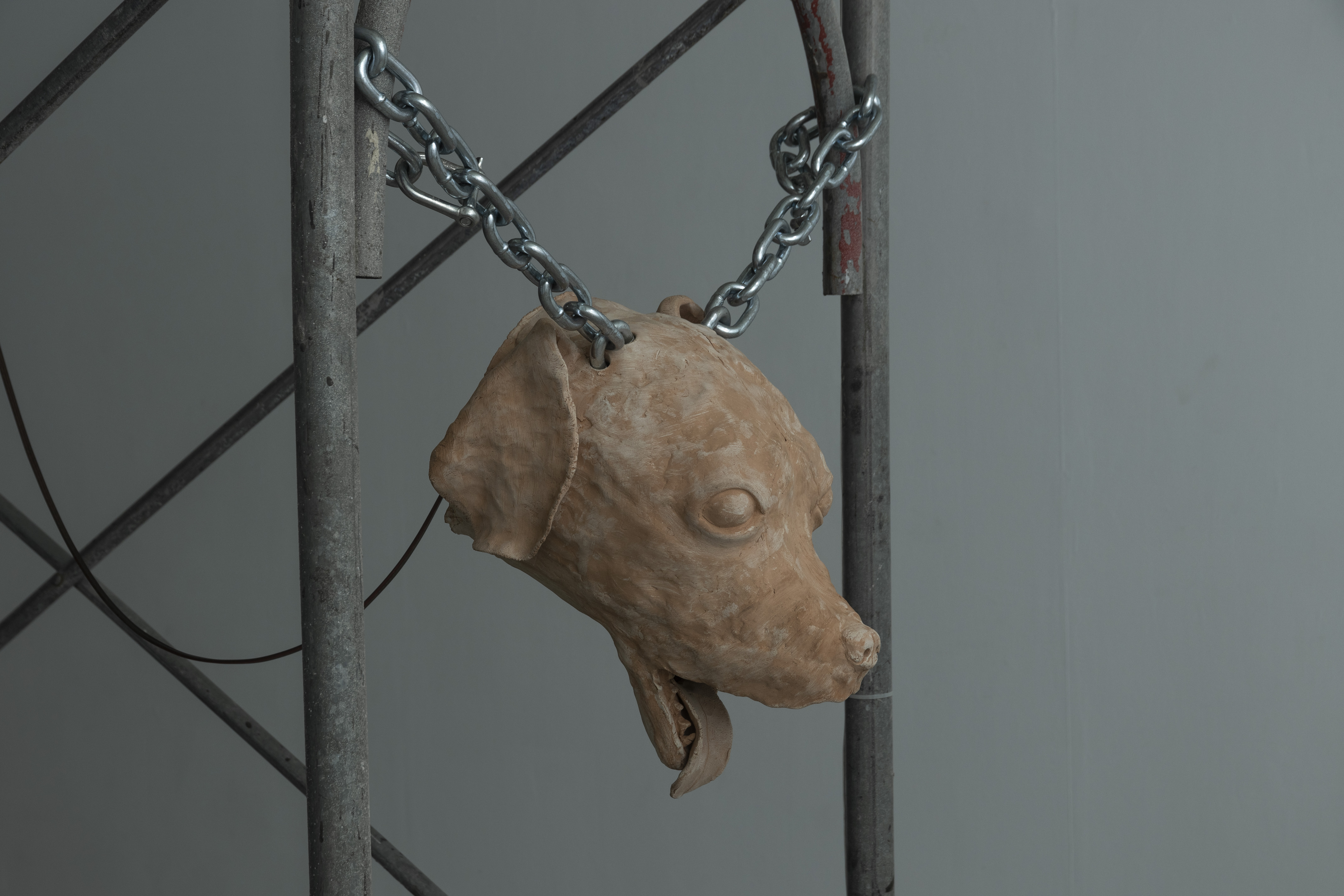Soil Dogs, 2023
Ceramics, geophone, speakers, vlf-recordings, infrasound
Throughout human history, different method of earthquake detection have been explored; from looking at unusual cloud formation to measuring electromagnetic anomalies. Folklore all over the world has shown a tendency to attribute heightened seismic perception to different more-than-human animals, in particular dogs. After almost every major earthquake, anecdotal evidence pops up of unusual behavior like barking, howling, and general unrest among dogs living close to the earthquake’s epicenter. The 1999 earthquake in Taiwan, and the devastating recent earthquake in Turkey and Syria are no exceptions.
![Dog Head 1 - Soil Dogs - Stef Veldhuis 2023 - Ceramics, geophone, speakers, vlf-recordings, infrasound - Photo by YiHsuan Peng]() Soil Dogs at Zit-Dim Art Space in Tainan city - Photo by YiHsuan Peng, 2023
Soil Dogs at Zit-Dim Art Space in Tainan city - Photo by YiHsuan Peng, 2023
With the embrace of indigenous knowledge by the scientific community, more research has been conducted into canine responses to early earthquake warning signs. Recent findings by researchers all over the world have led many to speculate the use of dogs as biosensors to aid in the detection of tectonic movements well before man made instruments can.
![Soil Dogs - Stef Veldhuis 2023 - Ceramics, geophone, speakers, vlf-recordings, infrasound - Photo by YiHsuan Peng]()
Wild formosan dog spotted during a research trip - Photo by YiHsuan Peng, 2023
The installation “Soil Dogs” explores the relationship between canines and seismic activity. Through a combination of ceramics, geo-acoustic and electromagnetic recordings, Veldhuis connects the assumed earthquake warning signs to the local soil of Taiwan. A soil that has been shaped and is constantly reshaped by the seismic fluctuation of the island situated on the fault line between the Eurasian and Philippine Sea plates.
![Dog head 2 - Soil Dogs - Stef Veldhuis 2023 - Ceramics, geophone, speakers, vlf-recordings, infrasound - Photo by YiHsuan Peng]()
Soil Dogs at Zit-Dim Art Space in Tainan city - Photo by YiHsuan Peng, 2023
The shapes of the ceramic dog heads resemble the gargoyles from Gothic architecture. These sculptures, found mostly on medieval churches, served the purpose of channeling rainwater away from the structure, whilst their monstrous shapes were believed to protect the building from evil spirits.
![Soil Dogs full exhibit Soil Dogs - Stef Veldhuis 2023 - Ceramics, geophone, speakers, vlf-recordings, infrasound - Photo by YiHsuan Peng]()
Soil Dogs at Zit-Dim Art Space in Tainan city - Photo by YiHsuan Peng, 2023
------------------------------------------------------
I am forever grateful to all who have helped me in creating this work. In particular Peng Yi-Hsuan for his friendship, his wisdom, and for accompanying me on the myriad adventures this research necessitated; to Huang Hung-Yu for her immense patience and kindness while teaching me her craft; to Nigel Brown for his sonic council; to Fu Zi-Jun for puzzling out the wooden construction; and of course, to Huang Kuan-Wen and Cheng Ming-Chun for all their ceramic and emotional support.
Soil Dogs has been created with the generous support of the Amarte Fund
 Soil Dogs at Zit-Dim Art Space in Tainan city - Photo by YiHsuan Peng, 2023
Soil Dogs at Zit-Dim Art Space in Tainan city - Photo by YiHsuan Peng, 2023With the embrace of indigenous knowledge by the scientific community, more research has been conducted into canine responses to early earthquake warning signs. Recent findings by researchers all over the world have led many to speculate the use of dogs as biosensors to aid in the detection of tectonic movements well before man made instruments can.

Wild formosan dog spotted during a research trip - Photo by YiHsuan Peng, 2023
The installation “Soil Dogs” explores the relationship between canines and seismic activity. Through a combination of ceramics, geo-acoustic and electromagnetic recordings, Veldhuis connects the assumed earthquake warning signs to the local soil of Taiwan. A soil that has been shaped and is constantly reshaped by the seismic fluctuation of the island situated on the fault line between the Eurasian and Philippine Sea plates.

Soil Dogs at Zit-Dim Art Space in Tainan city - Photo by YiHsuan Peng, 2023
The shapes of the ceramic dog heads resemble the gargoyles from Gothic architecture. These sculptures, found mostly on medieval churches, served the purpose of channeling rainwater away from the structure, whilst their monstrous shapes were believed to protect the building from evil spirits.

Soil Dogs at Zit-Dim Art Space in Tainan city - Photo by YiHsuan Peng, 2023
------------------------------------------------------
I am forever grateful to all who have helped me in creating this work. In particular Peng Yi-Hsuan for his friendship, his wisdom, and for accompanying me on the myriad adventures this research necessitated; to Huang Hung-Yu for her immense patience and kindness while teaching me her craft; to Nigel Brown for his sonic council; to Fu Zi-Jun for puzzling out the wooden construction; and of course, to Huang Kuan-Wen and Cheng Ming-Chun for all their ceramic and emotional support.
Soil Dogs has been created with the generous support of the Amarte Fund